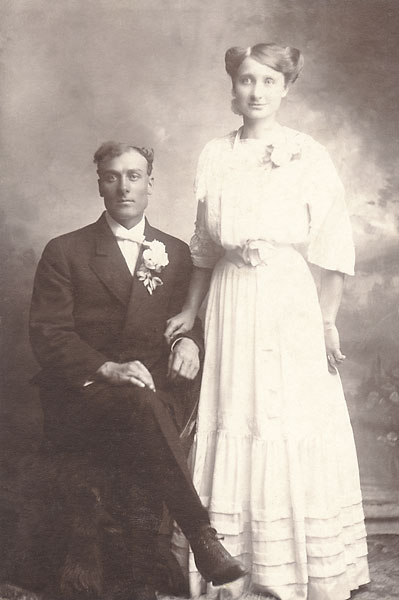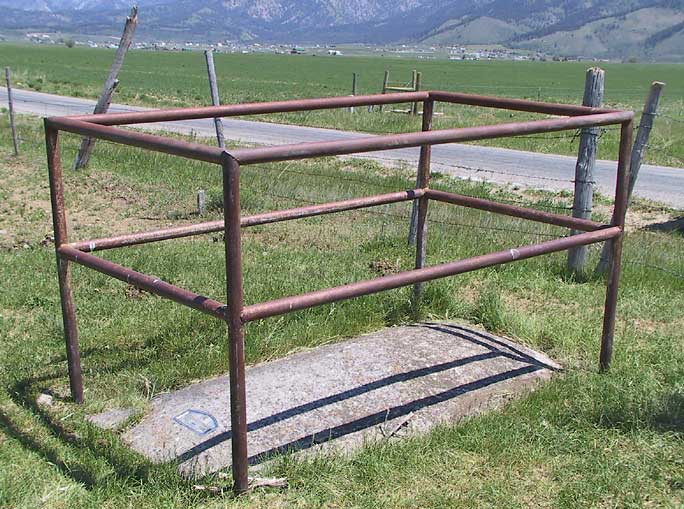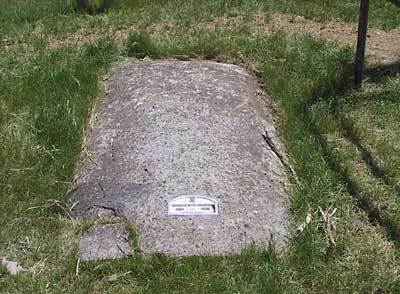 |
||
|
Left behind in Wyoming, she has been found again!
The man in the picture above is John Russell Hadden, born 19 April 1855 in Harmony, Washington, Utah, the son of Alfred Sidney Hadden and plural wife Sarah Ann Carter. With this wife Alfred Sidney had about 11 children, the oldest two of which were born in Iowa, and the others in Southern Utah (especially Iron County). John Russell Hadden's full sister Mary Ellen Hadden was born in Parawan, Iron, Utah on 10 October 1861 and she married Melvin Ross whose daughter from his first marriage had married William Morgan. It was this connection that brought John Russell Hadden into contact with Hannah Elizabeth Morgan. John Russel Hadden died in 1927 in Ririe, Jefferson, Idaho. The woman in the picture above is Hannah Elizabeth Morgan, born 4 October 1866 in Pleasant Grove, Utah and died 22 May 1889 in Freedom (Etna) Wyoming. This picture was taken at the time of the wedding of John and Hannah, probably in 1883. We are not sure of the date or place
of this wedding because we have not been able to locate the marriage record. It is possible that this marriage took place
in Neeley, Idaho since the parents of Hannah Elizabeth and John's sister (Mary Ellen Hadden Ross)and her family lived in Neeley
in the years immediately before this marriage. However, it is also possible that this marriage took place in one of the towns
in Utah where John Russell Hadden's family lived in the early 1880's. This would explain why the record has not been found
in Neeley, Idaho or Leamington, Utah.
LIFE HISTORY OF HANNAH ELIZABETH MORGAN HADDEN by James K Morgan Hannah Elizabeth Morgan was born 4 October 1866 in Pleasant Grove, Utah. Her parents, Edward (Ted) Morgan and Sarah West Morgan, were living in Goshen, Utah at the time but Hannah was born in Pleasant Grove because Sarah went to her stepmothers home to give birth. The story of Hannah Elizabeth's short life in America really begins with the conversion of her grandparents, Thomas Morgan and Nancy (Ann) Watkins Morgan to the Church of Jesus Christ of Latter Day Saints in Herefordshire, England in September 1851 and February 1852. Ann joined the church a few months later than her husband because her family was bitterly opposed. Thomas Morgan was a farm laborer who had been orphaned, and went to work in the fields, at the age of 9. Nancy (Ann) Watkins was the daughter of a blacksmith and was working as household help at a farm in Herdfordshire when she married Thomas Morgan in the Avenbury Parish Church 17 April 1843. Hannah Elizabeth's father, Edward (Ted) Morgan, was the firstborn child of Thomas Morgan and Nancy (Ann) Watkins Morgan. Edward
Morgan was born 16 May 1843 in the Bishops Frome Parish, Herefordshire, England. He was baptised into the LDS Church along
with his mother in February 1852. After the 1851/1852 conversion of Edward and his parents to the LDS church the family made
plans to emigrate to America and join the Latter Day Saints in their exodus to Utah. Edward and his uncle Joseph Morgan, who
had also converted to the Mormon church, were sent ahead, leaving England 15 February 1853, when Edward was three months short
of his tenth birthday and his uncle Joseph was 30 years old. They sailed from Liverpool on the wooden ship Elvira Owens, arriving
in New Orleans 31 March 1853. Edward and Joseph then made their way by steamship up the Mississippi River to St. Louis, on
to Iowa, and then to Utah in a wagon train led by Jacob Secrist, arriving in the Salt Lake Valley 10 October 1853. Edward
turned 10 years old during the six week period spent in Iowa gathering provisions for the wagon trip to Utah.
Edward (Ted) Morgan's parents, Thomas and Ann Morgan, along with Edward Morgan's sisters Elizabeth, Eliza, and Priscilla,
left England for America 27 February 1855. They sailed on the wooden ship Siddons from Liverpool, England, arriving in Philadelphia
21 April 1855. They made their way to Mormon Grove, Kansas, where they remained until fall, probably working on the farms
there to produce food for wagon trains. They left Mormon Grove 5 August 1855 and traveled with the Milo Andrus wagon train,
arriving in the Salt Lake Valley 24 October 1855. They made their way to Kaysville, Utah, about 20 miles north of Salt Lake
City, where they were reunited with Edward (Ted) Morgan and his uncle Joseph who had settled there two years earlier.
Joseph Morgan married Hannah Weaver (also a native of Bishops Frome Parish in England and a relative of Ann Watkins) in Kaysville
in 1856 and they stayed in Kaysville the rest of their lives. The Thomas Morgan family, however, moved on to pioneer new
communities in Utah, including Goshen, which is where Edward (Ted) Morgan met Sarah Jane West. They were married on 17 May
1862. Sarah was also a native of England. She was born in Borrowash, Derbyshire 8 November 1842 and came to America with her
parents at the age of 11.
Edward and Sarah West Morgan lived in Goshen until about 1866 and their first two children, Annie Lydia and Hannah Elizabeth,
were born in the nearby communities of Spanish Fork and Pleasant Grove. This brings us back, in our history, to Hannah Elizabeth
Morgan. Soon after Hannah was born her parents moved, along with her grandparents, to the newly established community of Deseret
on the Sevier River in Millard County, Utah. Here they lived in a dugout while they built irrigation systems and a large fort.
In about 1868 or 1869 Hannah's parents and grandparents moved again, this time to help found a new LDS Church sanctioned and
planned community at Oak City, Utah. In the early 1870's Hannah's parents were homeowners in Oak City. Then, after some time,
Hannah's parents and grandparents moved to new homesteads in what is now Leamington, Utah, where they again lived in dugouts
until they could construct cabins on top of the dugouts. Her parents and grandparents spent most of the 1870's in Leamington,
working together, farming their lands on the South side of the Sevier River.
In the fall of 1881, when her parents decided to move again, to pioneer yet another new frontier, Hannah Elizabeth Morgan
was 15 years old and had spent all of her youth living in dugouts and crude log cabins while her parents broke out new land,
built irrigation systems, and farmed on the harsh frontier. Pioneering new land was at the heart of Hannah's childhood experience
and was to be the dominant theme of her entire life, with each new move becoming progressively more difficult.
In the fall of 1881 Hannah's parents, along with the families of some of her aunts and uncles, loaded all their possessions
in wagons and moved north to homestead new land near the Snake River in what was then called Neeleyville, Idaho (Near American
Falls). However, this time her grandparents, Thomas and Ann Morgan, did not move with them, but stayed behind in Leamington.
They arrived in Idaho just in time for the first winter storm and had to live in and under their wagons until they could get
dugouts built. In this group of pioneering families were Hannah's older sister Annie Lydia who had married Willard Moore,
her younger sister Sarah Priscilla who had married Frank Ryset, her uncle William Morgan who had married Lovina Ross, her
uncle James John Morgan who had married Amberzine Guston, and Melvin Ross with his second wife Mary Ellen Hadden. Lovina
Ross, wife of William Morgan, was the oldest daughter of Melvin Ross and his first wife, Julia Elizabeth Smith.
In Hannah Elizabeth's household at this time were her younger brothers Edward Thomas Morgan, William Henry Morgan, and Joseph
John Morgan, and her younger sister, Mary Emma Morgan, who was still an infant.
While living in dugouts and struggling to prove up on their homesteads in Idaho Hannah's uncle Willard Moore caught diphtheria
while working in a logging camp. He returned home ill and exposed his family and others to the disease. Willard and Annie's
oldest child (Joseph Edward Moore, age 1 year 3 months) and two of Hannah's younger brothers (William Henry, nearly 8 years
old, and Joseph John, 4 years 8 months old) died during this most difficult time. The men scrounged wrecked wagon box wood
from the Snake River to make caskets for the three youngsters.
After farming for a few years in the Neeleyville area of Idaho all of the families except one of this pioneering group moved back to Leamington, Utah. Only Hannah's uncle William and aunt Lovina Ross Morgan family stayed in what was by then called Neeley, Idaho. But the connection had been made that would lead to Hannah's marriage. The first wife of Melvin Ross, and mother of Lovina Ross Morgan, had died and Melvin Ross had married again to Mary Ellen Hadden. Mary Ellen Hadden's brother, John Russell Hadden, probably accompanied Mary Ellen and her husband Melvin Ross when they settled in Neeleyville. Through this association Hannah Elizabeth Morgan met John Russell Hadden, brother of Mary Ellen Hadden. By 1887 all the families that had pioneered in Idaho, except the one family that stayed in Idaho, had returned to Leamington, Utah. In about 1883 Hannah Elizabeth married John Russell Hadden. This marriage probably took place in Idaho, since both Hannah's family and John's sister and her family were living in Neeleyvile. But it could have taken place in one of the towns in Utah where John's family lived in the early 1800's. We are a little unclear about this period in Hannah's life because we have not found the marriage record. Hannah gave birth to a child, John E. Hadden, 27 August 1884. Since Hannah would have been living at home in Neeleyville until she married and her pioneering families did not move back to Utah from Idaho until about 1887, it is most likely that Hannah and John were married in, and had their first child in, Neeley, Idaho. The pioneering Morgan clan we have been discussing in this history did not stay long in Leamington. By 1888 they had hatched
a new pioneering plan based on stories they heard about the tall grasses that grew in what is now called Star Valley, Wyoming.
The stories must have made Star Valley sound really good because this pioneering exodus from Utah was to include not only
Hannah and her husband, parents, and aunts and uncles, but two senior pioneering clan members, who were getting a little old
for pioneering a new frontier. Hannah's grandfather, Thomas Morgan, had married a second wife, Nancy Jane Radford, 25 September
1871, and Thomas and his two wives were living in two homes on their homestead in Leamington, Utah. In 1888 Thomas was 65
years old. John Whitlock Radford, whose daughter had married Thomas Morgan, and whose two sons had married daughters of Thomas
Morgan, was 74 years old in 1888. Both of these old pioneers decided to pioneer once more, this time in Wyoming. A number
of related Lovell, Woolsey and Ross families moved to Star Valley with them. Leah Ellen Radford Lovell and Diana Rebecca Radford
Woolsey were daughters of John Whitlock Radford and his wife Rachel Leah Smith. Richard (Dick) Ross, brother of Melvin Ross
and son of Rachel Leah Smith from her first marriage, made the move to Wyoming. But Melvin Ross, who had earlier run into
some personal difficulties that landed him in the Utah territorial prison, did not go with the families to Wyoming.
So, in late 1888 or in 1889 these families loaded their belongings in wagons and, driving their cattle, made the trek to Wyoming.
Railroads were running by this time but would have been too expensive given the amount of livestock, wagons, tools and possessions
that had to be taken along. The area these families picked to homestead was in the lower end of the Star Valley just south
of the Idaho border, not far from where the Salt River flows into the Snake River in Idaho. This area was called Freedom when
Hannah's families settled there, and is near where the town of Etna is today.
Homesteading in Star Valley, Wyoming was, for Hannah's families, a disaster from the outset. Hannah and her pioneering families
got there too late in 1888 to cut and store the plentiful grasses but felt they could manage by letting their livestock graze
in the fields during the winter. Settlers from Idaho had been bringing cattle to graze in Star Valley for some time and it
was known that some winters were mild enough to allow the cattle to graze all winter. But the winter of 1888-89, one of the
worst on record, brought deep snows that buried the grass and the livestock were hard put to dig food out of the snow. The
next summer Hannah's families found the grasses too thick and too interspersed with brush to be cut and stored. They did not
have adequate equipment for such a task. And a drought much reduced the grass crop that summer. So they went into the second
winter without enough stored livestock feed and again the winter brought deep snows. Before spring family members were making
trips out of the valley to secure wheat to help feed their families. And by spring all their livestock had starved except
the horses, which they kept alive by cutting willows to feed to them. One account stated that by spring all the livestock
had starved or froze to death except one heifer and the dogs killed that.
Hannah Elizabeth Morgan Hadden died 22 May 1889 either during, or soon after, childbirth, about four months short of her twenty third birthday. Her mother, a hardened pioneer who had experienced death before, prepared the body for burial, assisted by Hannah's older sister Annie Lydia and her younger sister Sarah Priscilla. Hannah's family wanted to take her body to Freedom for burial but John Hadden refused and, being the husband, had first right. So Hannah was buried on the bank of a warm spring swale that never freezes over. Hannah's second child, Francis E., survived her and was taken by Hannah's mother Sarah West Morgan who, along with Hannah's
sister Priscilla, nursed it. But John Hadden asked to have the baby. Reluctantly it was given to him. Sarah West knew that
John, living in stark conditions, did not have the means to care for a baby. Baby Francis E. died soon after and we know not
where he is buried. Hannah's first child, John E. Hadden, was brought by his father to Rudy, Idaho (near Ririe), survived
to maturity, married Annie Myrtle Nielson, and apparently lived, and farmed, in Idaho most of his life. John Russell Hadden
remarried in Idaho to a woman named Lydia.
John Whitlock Radford died 14 December 1889 and was buried near a cabin just West of where the Etna store stood. Later his body was moved to the Shelton, Idaho cemetery where it rests beside his wife, Rachel Leah. Hannah's grandparents, Thomas and Ann Morgan, and Thomas' second wife Nancy Jane Radford, survived the Wyoming experience and lived to pioneer once again in Idaho. Thomas homesteaded land in the Poplar area along the Snake River above Heise Hot Springs and ran a ferry across the river for many years. Thomas Morgan's first wife, Ann, died 19 August1895, four years after leaving Wyoming and his second wife, Nancy Jane, died 10 May 1900 in Poplar. Thomas died at the home of his daughter Priscilla 6 July 1915. Joseph Hyrum Lovell died 16 June 1892, at Shelton, Idaho, at the age of 48, one year after moving on to Idaho from Wyoming. It is easy to believe that the Wyoming experience took a heavy toll on them all. Not defeated by the Wyoming disaster, Hannah's pioneering families moved on to Idaho where they homesteaded once again in the Shelton/Antelope/Poplar area. Her parents homesteaded land and built a home near Ririe and within sight of the Shelton cemetery. Their pioneering days finished, they spent the rest of their lives on this land, close to Thomas Morgan and their extended Morgan, Radford, Moore, Ryset, Brown and Ross families. Hannah's sister Annie Lydia and her husband Willard Moore homesteaded land near Ririe, built a house on it, and later donated a corner of their land for the Shelton Cemetery. Her sister Sarah Priscilla and husband Frank Ryset farmed in the Shelton and Antelope area the rest of their lives. Her sister Mary Emma married Frank Brown and they also farmed in the Shelton area the rest of their lives. They are all buried together in the Shelton cemetery. Members of this family regularly made the trip back to Wyoming on Memorial day to tend Hannah Elizabeth's grave. But when this generation passed away the location of Hannah's grave was lost to the Morgan family. Hannah's brother Edward Thomas Morgan married Violet Richardson and they settled in Neeley, Idaho. When Violet died in 1909 Edward Thomas moved to Shelton to be near the extended Morgan family that had settled there. Hannah's uncle, William Morgan, farmed in Neeley until his wife, Sarah Lovina Ross Morgan, died in 1919, then he too moved to Shelton to be near his Morgan families. Her brother, Robert Morgan, spent his life in the Shelton area and died there in 1939 at the age of 56. In 1897 Melvin Ross, after he and some of his sons had struggled for years to earn a living in Utah, also returned to Shelton to spend his latter years, arriving too late to see his mother Rachel Leah Smith Ross Radford, who died before he arrived. The story of the short life of Hannah Elizabeth Morgan Hadden is about pioneering, hardship, family, and faith. She never experienced in her life anything but the hardships of the cutting edge of frontier life. In less than 23 years she had lived on, and worked to help establish, six different homesteads. This was an average of just under four years spent on each homestead. The first four years on a new homestead were by far the most grueling. Brush and trees had to be cleared, rocks dug up and moved, dugouts and cabins built, irrigation systems dug, crops planted and harvested. Hannah spent her entire life in the stark and unforgiving environment of new raw homesteads. There was no end to the hard work. She never lived in a city, a town, or even on an established farm. She probably never owned much in the way of store-bought goods. They made most of their own clothes and grew most of their own food. She lived her entire life in wagons, tents, dugouts and crude log cabins. She worked hard from childhood to death at taking care of herself and her family in times when water was carried from the creek in buckets, food was prepared from scratch, clothes were washed on a washboard in a tub, farm work was done by hand or with horses and travel in a light buggy pulled by horses was a luxury. Hannah's was a short life of drudgery and she was denied the experience of growing old with her own family around her. But she lived, and died, with her parents and extended family around her. These families were strong in their faith in God, in their faith in their church, and in their belief in the unity of families. They were forced by circumstances to leave Hannah Elizabeth Morgan behind in a lonely grave in what was then a remote wilderness in Wyoming. But we have not forgotten her. Leon Pitman and James Morgan have published a book documenting the history of Hannah Elizabeth's grandfather, father and siblings.
It is titled "History of Thomas Morgan and his families with Ann Watkins and Nancy Jane Radford." All copies have
been sold but reference copies have been placed with family history libraries in Idaho Falls, Idaho, and Ririe, Idaho, at
BYU Idaho in Rexburg, BYU Provo, and the LDS Church family history library in Salt Lake City. Unbound copies of this book
can be obtained by contacting Leon Pitman, 48 West 300 South #1405, Salt Lake City, Utah 84101.
|
|||
|
The picture above is of the gravesite of Hannah Elizabeth (Lizzie) Morgan Hadden who died while her family was pioneering
in Star Valley, Wyoming. Our family account says she was buried on the bank of a swale. However, it is clear from this picture
that she was buried beside a road, which may have been little more than a wagon track at the time. We are told that her family
came back to this grave from the Ririe/Shelton area for many years to visit and tend the grave. The grave has been protected
by a steel fence and concrete cover, which were probably put in place by her family many years ago. After Hannah Elizabeth's
parents and siblings passed away the location of this grave was lost to us. While doing research for the Thomas Morgan family
book we often wondered where Hannah Elizabeth's grave was and we had no hope of finding it. We presumed that it had been unmarked
and would have been overgrown and impossible to locate. However, the fact that her family clearly marked and protected the
grave, allowed it to be found again. Researchers in Star Valley, Wyoming, have been aware of the grave for years and have
been wondering who is in it. Fortunately the Wyoming researchers found our morganclan.com website and contacted us. Everyone
was overjoyed that the grave had been located and the family informed of it's location.
The picture above shows the concrete protective covering over Hannah Elizabeth Morgan Hadden's grave, and the metal plate with "Hannah E. M. Hadden" and her birth and death dates written on it. Driving Directions to Hannah Elizabeth Morgan Hadden's gravesite: Travel due north on highway 89 from Etna, Wyoming approximately 0.4 mile. Turn left (West) on highway 111 (Jacknife Road). Travel 0.7 mile then turn right (North) on highway 109 (Roberts-Wolfley Road). The gravesite is 0.2 mile on the left (West). About 50 ft. South of the site is a telephone pole with a green metal fence gate attached. The site itself is marked with a welded pipe fence which was newly anchored and painted in summer 2007. Hannah Elizabeth Morgan Hadden Memorial Click on the link above to see a memorial picture made for Hannah Elizabeth Morgan Hadden. |
|||


